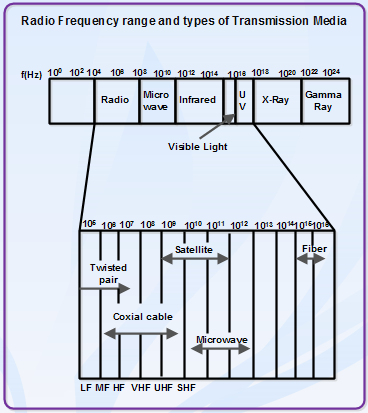Radio waves, also called radio waves as they were discovered by German physicist Heinrich Hertz in 1888, are electromagnetic waves, that is to say the combined oscillation of an electric field and a magnetic field. Radio waves, infrared, visible light, ultraviolet, X-rays or gamma rays are all examples of electromagnetic waves.
It is a technique where data is transmitted using radio waves and therefore energy travels through the air rather than copper or glass. Conceptually, radio, TV, cellular phones etc. uses radio transmission in one form or another. The radio waves can travel through walls and through an entire building. Depending upon the frequency, they can travel long distance or short distance. Satellite relay is the one example of long distance communication.
Therefore, each frequency range is divided into different bands, which has a specific range of frequencies in the radio frequency, (RF) spectrum. The RF is divided in different ranges starting from very low frequencies (VLF) to extremely high frequencies (EHF). Figure shows , each band with a defined upper and lower frequency “limit.
 Two transmitters cannot share the same frequency band because of mutual interference and therefore band usage is regulated. International use of the radio spectrum is regulated by the International Telecommunication Union (ITU). Domestic use of the radio spectrum is regulated by national agencies such as Wireless Planning and Coordination (WPC) in India. WPC assigns each transmission source a band of operation, a transmitter radiation pattern, and a maximum transmitter power.
Two transmitters cannot share the same frequency band because of mutual interference and therefore band usage is regulated. International use of the radio spectrum is regulated by the International Telecommunication Union (ITU). Domestic use of the radio spectrum is regulated by national agencies such as Wireless Planning and Coordination (WPC) in India. WPC assigns each transmission source a band of operation, a transmitter radiation pattern, and a maximum transmitter power.
Omni-directional or directional antennas are used to broadcast radio waves depending upon band. The transceiver unit, which comprises transmitter and receiver along with the antenna, determines the power of RF signal. Other characteristics of radio waves is that in vacuum all electromagnetic waves or radio waves travel at the same speed, i.e. at the speed of light which is equal to 3 x l08·meter per second. In any medium this speed gets reduced and also becomes frequency dependent. In case of copper the speed of light becomes approximately two-thirds of the speed of light.
The basic features of the radio waves are that:
• they are easy to generate
• they have same velocity in vacuum
• they may traverse long distances
• they are omni-directional
• they can penetrate building easily so they find extensive use in communication both indoor and outdoor
• they are frequency dependent. At low frequency they can pass through obstacles well but the power falls off sharply With distance from the source, as power is inversely proportional to cube of the distance from the source. At HF they travel in straight lines and bounce off obstacles.
Very Low Frequency (VLF)
The VLF method takes advantage of electromagnetic radiation generated in the low frequency band of 3-30 kHz by powerful radio transmitters used i~ long-range communications and navigational systems. At long distances from the source’, the electromagnetic field is planar and horizontal and the electric component E lies in a vertical plane perpendicular to the H component in the direction of propagation and follow the ground. AM uses VLF band. This band of frequencies cannot be used for data transfer because they offer relatively low bandwidth.
The following are the problems associated with radio frequency transmission.
Path Loss: SNR or signal to noise ratio is defined as the ratio of power of the received signal to power of the noise in the received signal. The performance of the communication system is good if this factor is improved. But the design will be more complex if this parameter is to be improved. Either increasing the transmitting power or reducing the distance between the transmitter and receiver can improve SNR.
Adjacent channel interference: Interference is another phenomenon that affects the radio frequency transmission, when the same frequency band is allocated to two adjacent transceivers, resulting in interference. Hence interference occurs when one useful signal is mixed up with another signal. This problem can be avoided by dividing the available band into sub-bands and allotting different bands to adjacent transceivers.
Multipath: Another problem with radio wave transmission is due to Multipath. A receiver at any point can get two types of signal from the transmitter. One is the direct signal and the other is the reflected signal. Every object reflects the radio wave. Hence, the receiver can get multiple reflected signals through various paths. The signal strength is additive at certain points and out of phase at some other points. Hence the receiver can get peak power at some points and minimum power at some other points. This phenomenon is known as frequency selective fading. By employing two antennas at quarter wavelength separation, this problem can be solved.
 Dinesh Thakur holds an B.C.A, MCDBA, MCSD certifications. Dinesh authors the hugely popular
Dinesh Thakur holds an B.C.A, MCDBA, MCSD certifications. Dinesh authors the hugely popular